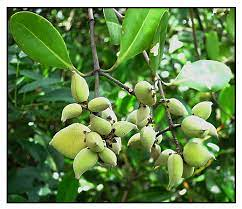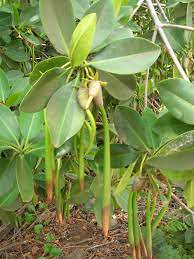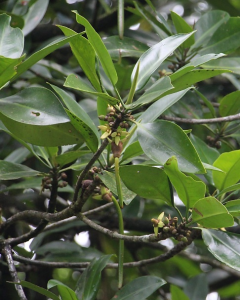
Pokok Bakau Api-Api (Avicennia)

Avicennia is a genus of flowering plants currently placed in the bear’s breeches family which is Acanthaceae. It contains mangrove trees, which occur in the intertidal zones of estuarine areas and are characterized by its “pencil roots”, which are aerial roots. They are also commonly known as Api-Api, which in the Malay language means “fires”, a reference to the fact that fireflies often congregate on these trees. The genus Avicennia is named after the famous Persian scientist Ibn Sina.
Members of the genus are among the most salt-tolerant mangroves and are often the first to colonise new deposits of sediment. The sap is salty, and excess salt is secreted through the leaves. The spreading root system provides stability in shifting substrates. The vertical roots called pneumatophores are used in gas exchange as very little oxygen is available in the mud. The flowers are fragrant and rich in nectar and are pollinated by insects. The embryos exhibit cryptovivipary, a process where they start to develop before the seed is shed, but do not break through the outside of the fruit capsule.
Pokok Bakau Kurap (Rhizophora Mucronata)

Rhizophora mucronata (loop-root mangrove, red mangrove or Asiatic mangrove) is a species of mangrove found on coasts and riverbanks in East Africa and the Indo-Pacific region. It regenerates easily from seed, but the seedlings are often damaged by crabs. The leaves are also eaten by crabs. Rhizophora mucronata used to help prevent coastal erosion and in restoration of mangrove habitats. The timber is used for firewood and in the construction of buildings, as poles and pilings, and in making fish traps. The fruits can be cooked and eaten, or the juice extracted to make wine, and the young shoots can be consumed as a vegetable. The bark is used in tanning and a dye can be extracted from both bark and leaves. Various parts of the plant are alos used in folk medicine.
Pokok Bakau Minyak (Rhizophora Apiculata)

It is located exclusively in the mangrove ecosystem due to an affinity to wet, muddy and silty sediments. Due to the high salt concentrations of the soils in these environments, it has mechanisms (ultrafiltration) in place to reduce the likely impacts associated with increased salt in plant physiology (drying plant material down causing increased evapotranspiration). The process of roots absorbing both water and nutrients is a fundamental process responsible for growth, however due to the environment in which it is grows being notably high in salt levels. The roots undergo a process called ultra-filtration to eliminate any salt from entering the plant however any salt taken up will be stored in old leaves that will eventually fall and die eliminating the salt capacity within the plant.
Rhizophora Apiculata are used to make charcoal in the charcoal kilns of Kuala Sepetang in Perak, Malaysia. It is also used within mangrove plantation specifically for wood, and charcoal production in many parts of Thailand; Yeesarn village of Smaut Songkram Province for instance. There are a variety of alternative uses including medically (to inhibit fungal infections), and commercially to reinforce nets, ropes and fishing lines, transform into charcoal or trade for income.